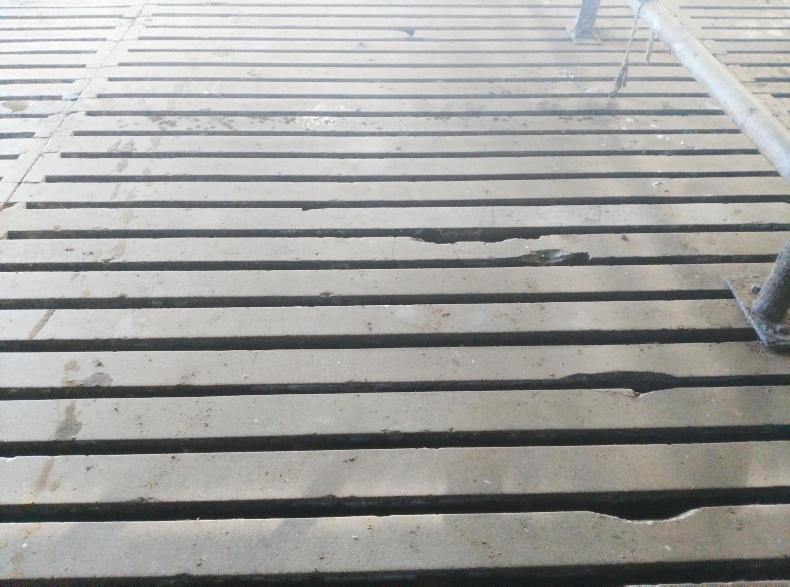After slats came into use decades ago, it was realised that steel was placed too near the outer surface of the concrete and was at risk of corrosion, leaving the slat at risk of collapse. Corrosion, or damage during installation, can allow slurry to come in contact with the steel. The steel eventually rusts, weakens and swells, cracking the concrete. One tell-tale sign that your slats need to be examined can sometimes be found in the fields. This is due to chunks of concrete falling off the underside of slats into the slurry tank below. From there they get sucked into the slurry tank and spread on the land.
Once you have an indication that slats may need to be changed, do a routine check.
Every year thoroughly clean the slatted floor, including any external manhole covers, and examine it for sagging, cracking, rust staining and spalling of concrete (breaking of layers or pieces of concrete from the surface).
Assuming the slats were laid evenly originally, the laying of a straight edge across the centre of the slats will indicate which slats have sagged.
For single slats, suspect slats should be lifted, power-washed and examined for cracks. Take care when doing this work, otherwise someone might fall into the tank or some slats could end up in the tank. Generally, gang slats would be expected to perform well for at least 15 years. However, there is always the possibility that one slat may be suspect for some unknown reason, so an odd check for sagging or a crack, even with relatively new slats, is a reasonable precaution.
When replacing slats, you should ensure the tank is fully empty before work starts. Check the measurements of the new slats correspond with the old ones. Make sure the seating and surrounding concrete is cleaned and there are no foreign objects. Ensure no one enters the tank during slat replacement. Slats should have a full bearing of at least 150mm on tank walls at either side. Also, take care if you are driving on a suspended passage with a load of gang slats. The passage may not be able to support the weight and it may be a better idea to bring each slat in on its own.

Old slats can be put to good use. Some farmers have built cattle pens with single slats stacked horizontally and secured between steel stanchions. Others use gang slats to do the same job by lowering one full gang slat with straps between the steel stanchions and cutting a second one in half and lowering it on top. Cutting gang slats in half to construct a feeder is also an idea.
TAMS II grants for replacement slats
If you decide slats need to be replaced, you may be entitled to a grant as part of TAMS II. According to the Department of Agriculture, if applying for grant aid for replacing slats, any existing internal agitation points within a building have to be removed as part of the slat replacement works. Also, the Department says that upon completion of the slat replacement works, all tanks have to have facilities for the full agitation of slurry from points outside the building or have a simple aeration system installed. It should be noted that any items that are pre-cast, such as slats, beams, suspended passages, concrete blocks, etc, need a CE mark to be grant-compliant.
Remember the minimum investment rate in a TAMS application is €2,000 excluding VAT.

Safety
Replacing cattle slats can be a dangerous job. This is because you have to work around the obstacle of a shed that wasn’t present when they were installed originally. If you are planning a replacement job it might be best to have an expert come out and assess the condition of pillars and beams to make sure they can carry the load of the replacements. Plan out the installation process with the slat supplier/installer to safely plan the removal of the old slats and the installation of the new ones. The slat supplier should be able to give advice on how to remove old slats and they usually provide an installation service. When using second-hand slats in construction, you should always be safety-conscious. Slats can be dangerous and need to be handled with respect. Make sure proper machinery is used in the installation and they are secured appropriately.






 This is a subscriber-only article
This is a subscriber-only article














SHARING OPTIONS: